Dadan (Arabie saoudite)
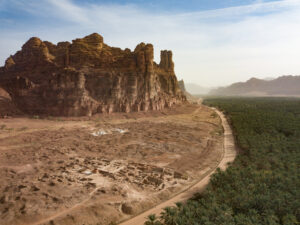
Vue générale de Dadan depuis le nord-ouest. ©Dadan Archaeological Project (CNRS/AFALULA/RCU). Photo X. Desormeau/J. Rohmer.
Située au cœur de la grande oasis d’al-ʿUlā, dans le Hedjaz, Dadan est l’une des principales villes antiques de l’Arabie du Nord-Ouest. Les premières traces d’occupation du site remontent à la fin du IIIe millénaire av. n. è., mais elle semble avoir atteint son apogée durant le Ier millénaire av. n. è., à la faveur du développement des échanges à longue distance le long de la « route de l’encens ». Mentionnée dans la Bible et dans les sources mésopotamiennes, elle fut alors la capitale de deux royaumes successifs : le royaume oasien de Dadan (première moitié du Ier millénaire), puis le vaste royaume tribal de Liḥyān (ve–iie siècle av. n. è. ?). Étape caravanière majeure entre l’Arabie du Sud, l’Egypte, le Levant et la Mésopotamie, Dadan accueillit également un important comptoir commercial de marchands sud-arabiques issus du royaume de Maʿīn. Combinant ces influences extérieures au substrat culturel local, elle développa une culture originale dont témoignent ses nombreuses productions artistiques ainsi que des milliers d’inscriptions gravées en dadanitique (la langue/écriture locale) ou en sud-arabique.
Lancé en avril 2019 avec le soutien de l’Agence française pour le développement d’al-ʿUlā (Afalula) et de la Royal Commission for al-ʿUlā (RCU), le Dadan Archaeological Project (DAP) combine fouilles archéologiques à grande échelle, prospections pédestres et études spécialisées (épigraphie, céramologie, archéozoologie, archéo-anthropologie) en vue d’une compréhension globale et diachronique du site de Dadan. Il comprend également un important volet de conservation/restauration, ainsi que des activités de formation (à destination d’étudiants saoudiens et français, pleinement intégrés dans l’équipe) et de médiation culturelle (à destination du public scolaire de la région).
A la suite d’une reconnaissance menée en avril 2019, trois premières campagnes de terrain et une campagne d’étude ont permis des avancées considérables dans la compréhension du site. Cinq grands secteurs de fouille, associant fouille extensive et sondages profonds, mettent en lumière les principales étapes du développement de la ville antique depuis la fin du IIIe millénaire av. n. è. jusqu’au début du Ier millénaire de n. è., mais aussi la persistance insoupçonnée de l’occupation du site lors des « âges obscurs » de la jahiliyyah (ive–vie siècles de n. è.) et à l’époque islamique ancienne (viiie-xiie siècle de n. è.). Dans les montagnes dominant le site, des prospections systématiques ont révélé plusieurs centaines de tombes, d’imposantes installations défensives et deux grands sanctuaires de hauteur, associés à des milliers d’inscriptions et de gravures rupestres. Des collaborations resserrées avec d’autres projets menés par le CNRS dans la région d’al-ʿUlā (projet archéobotanique ECO-Seed porté par l’UMR 7209, projet géo-archéologique ArcAgrAU porté par l’UMR 7264) permettent d’inscrire ces résultats dans un contexte plus large afin de comprendre les modalités et les cycles de développement de l’une des principales oasis d’Arabie du Nord sur la longue durée, du Néolithique à l’Islam.
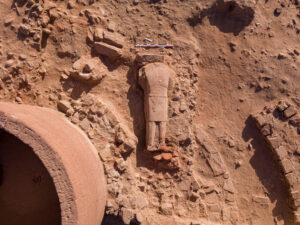
3. Statue colossale (hauteur : 2,21 m) mise au jour par le DAP lors des fouilles du sanctuaire de Dadan. ©Dadan Archaeological Project (CNRS/AFALULA/RCU). Photo X. Desormeau
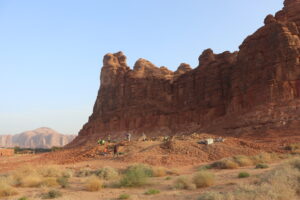
Grand bâtiment fortifié tardo-antique au sud du site (secteur E), en cours de fouille. ©Dadan Archaeological Project (CNRS/AFALULA/RCU). Photo B. Riba
English version
Located in the heart of the great oasis of al-ʿUlā, in the Hijaz, Dadan is one of the major ancient cities in northwestern Saudi Arabia. The earliest traces of occupation of the site date back to the late 3rd millennium BCE, but it seems to have reached its peak during the 1st millennium BC with the development of long-distance trade along the ‘incense route’, as shown by its mention in the Bible and in Mesopotamian records. During that millennium, Dadan was the capital of two successive kingdoms: the oasis kingdom of Dadan (first half of the 1st mill. BCE) and the larger, tribal kingdom of Liḥyān (5th–2nd cent. BCE). A major trade hub between southern Arabia, Egypt, the Levant and Mesopotamia, Dadan also hosted an important trading colony of South Arabian merchants from the kingdom of Maʿīn. Combining these outside influences with the local cultural substratum, it developed an original culture illustrated by numerous artistic productions and thousands of inscriptions engraved in Dadanitic (the local script and language) or in Ancient South Arabian.
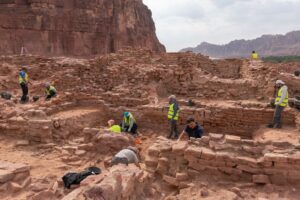
Fouilles d’un quartier d’habitation antique dans le centre de la ville (secteur C). ©Dadan Archaeological Project (CNRS/AFALULA/RCU). Photo J. Kramer
Launched in April 2019 with the support of the French Agency for the Development of al-ʿUlā (Afalula) and the Royal Commission for al-ʿUlā (RCU), the Dadan Archaeological Project (DAP) combines large-scale archaeological excavations, systematic field surveys and a wide array of specialized studies (epigraphy, ceramology, archaeozoology, archaeoanthropology) to gain a comprehensive, diachronic understanding of Dadan. It also includes an important conservation/restoration component, as well as training activities (for Saudi and French students, fully integrated into the team) and public outreach/community engagement initiatives (in particular for the school children of al-ʿUla).
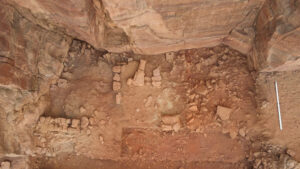
Vue zénithale d’un sanctuaire funéraire au pied de la falaise de Dadan (secteur D). De nombreux objets de culte (tables à offrandes, brûle-encens, statues, pierres dressées) y ont été retrouvés in situ. ©Dadan Archaeological Project (CNRS/AFALULA/RCU). Photo X. Desormeau
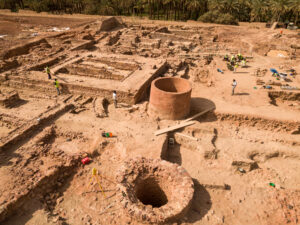
Vue du grand sanctuaire de Dadan (secteur B) en cours de fouille. Le centre du complexe comprend un puits (au premier plan), un grand bassin monolithe (au centre) et un bâtiment monumental (à l’arrière-plan à gauche). ©Dadan Archaeological Project (CNRS/AFALULA/RCU). Photo S. Lora
Following a reconnaissance survey in April 2019, the first three field seasons and one study season have enabled considerable progress in the understanding of the site. Five major excavation areas, combining wide exposure and deep trenches, have shed light on the main stages in the development of the ancient city from the end of the 3rd mill. BCE to the beginning of the 1st mill. CE. They have also revealed the unsuspected continuation of the site’s occupation through the « dark ages » of the Jahiliyyah (4th–6th cent. CE) and the Early Islamic period (8th–12th cent. CE). In the mountains overlooking the site, a systematic pedestrian survey has revealed several hundred tombs, massive defensive installations and two large mountain-top sanctuaries, associated with thousands of inscriptions and rock engravings. Thanks to close collaborations with other projects conducted by the CNRS in the al-ʿUlā region (ECO-Seed archaeobotanical project led by UMR 7209, ArcAgrAU geoarchaeological project led by UMR 7264), these results can be placed in a broader context and shed light on the development of one of the main oases of North Arabia over the longue durée, from the Neolithic to Islam.
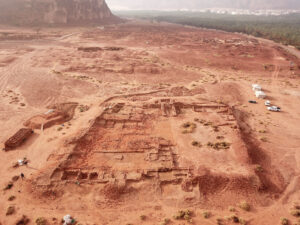
Vue aérienne du bâtiment monumental d’époque islamique ancienne, depuis le nord. ©Dadan Archaeological Project (CNRS/AFALULA/RCU). Photo X. Desormeau.
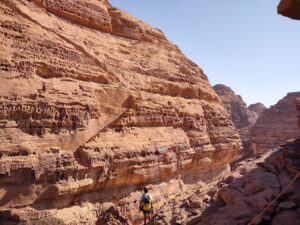
Escalier rupestre découvert lors des prospections des montagnes dominant Dadan (Jabal al-Khuraybah). ©Dadan Archaeological Project (CNRS/AFALULA/RCU). Photo B. Fourgous/T. Godet.
Articles
Articles
Rohmer J., Lesguer F., Bouchaud Ch., Purdue L., Alsuhaibani A., Tourtet F., Monchot H., Dabrowski V., Decaix A., Desormeau X., Alkhatib Alkontar R. & Reiller H. 2022 (accepted, in press), “New clues to the development of the oasis of Dadan. Results from a test excavation at Tall al-Sālimīyyah (al-ʿUlā, Saudi Arabia)”, in R. Foote, M. Guagnin, I. Périssé & S. Karacic (ed.), Revealing cultural landscapes in northwest Arabia. Papers from the Special Session of the Seminar for Arabian Studies held on 9 July 2021: 155–58 (Supplement to the Proceedings of the Seminar for Arabian Studies 51). Oxford: Archaeopress.
Grégor T., Rohmer J. & Alsuhaibani A., 2023 (accepted, in press), “Quarrying, carving and shaping the landscape. Stone working at Dadan, northwest Arabia, in the first millennium BCE and beyond”, in A. Lamesa, M.-E. Porqueddu, S. Roberto & C. Sciuto (ed.), From Quarries to Rock-Cut Sites. Echoes of Stone Crafting, Leiden: Sidestone Press.




